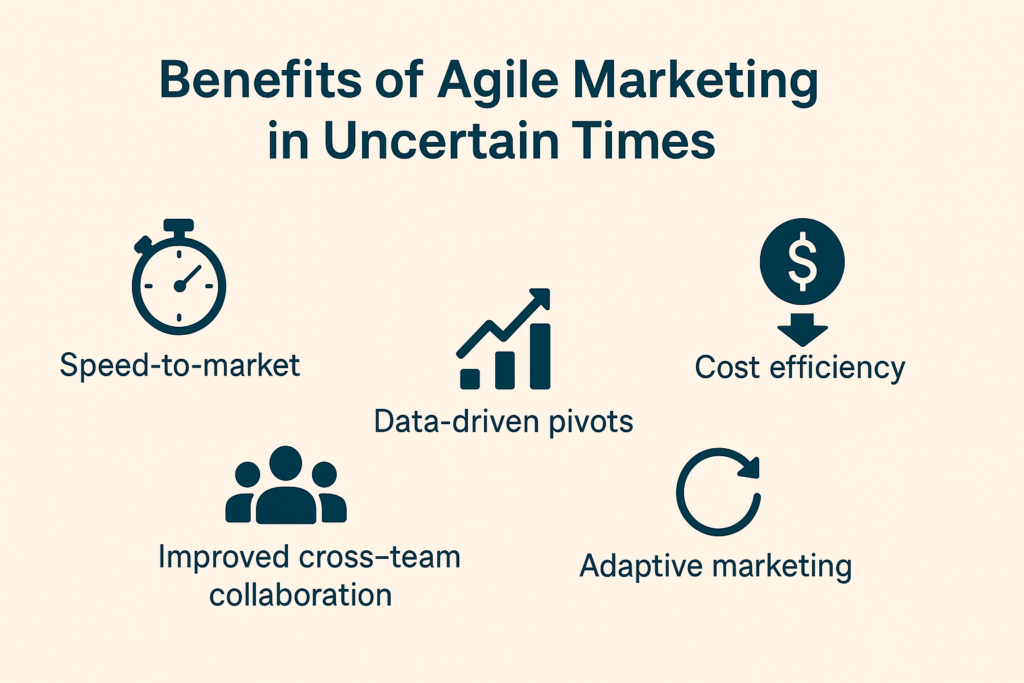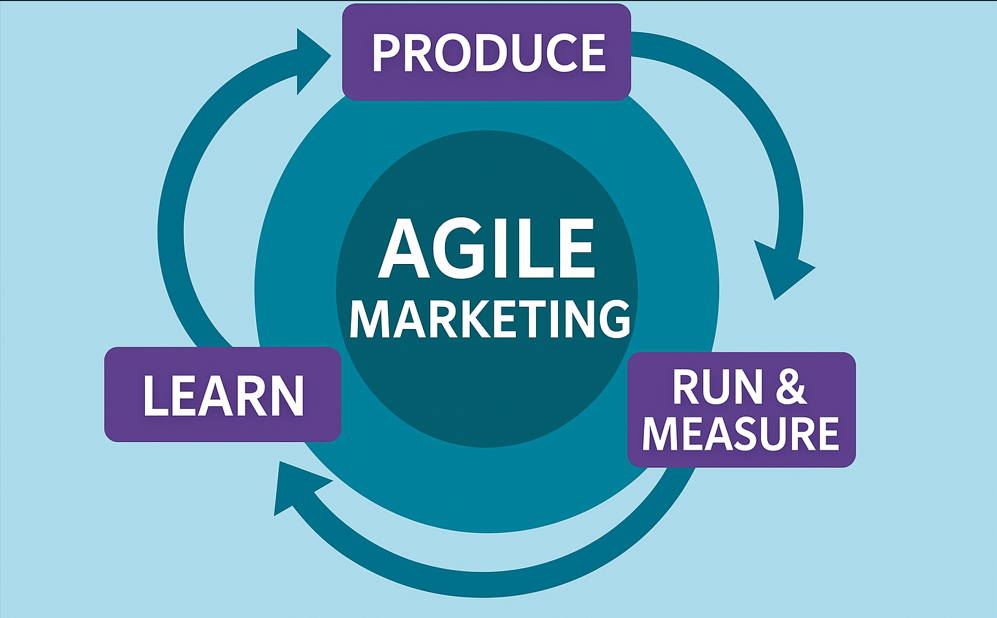Indeed, in an era of economic and market volatility, marketing in uncertain times demands rapid adaptation. Therefore, agile marketing allows brands to implement timely, meaningful messaging even as circumstances change. However, traditional marketing cycles often span months. As a result, teams struggle to keep pace with shifting customer behaviors and competitive pressures. Moreover, McKinsey reports that organizations adopting agile marketing can cut time to market from eight weeks to under two weeks. Consequently, they preserve relevance and momentum. Ultimately, this level of marketing agility and flexibility is no longer optional. It is critical for survival and growth.
What Is Agile Marketing?

Agile marketing is a tactical approach in which teams collaborate to identify high‑value projects and focus their efforts collectively. Additionally, it emphasizes self‑organization, experimentation, and delivering work in short, focused bursts. In marketing, agile methodology uses self‑organizing, cross‑functional teams. They work in frequent small bursts, called “sprints.” This approach enables rapid iteration based on continuous feedback and data. Agile marketing draws inspiration from the Agile Manifesto for software development. It borrows frameworks like Scrum and Kanban. However, it adapts them for campaign planning, content creation, and real‑time optimization.
Benefits of Agile Marketing in Uncertain Times

–Speed‑to‑market
First, agile teams move quickly. They focus on short‑term goals and launch campaigns in days or weeks rather than months. For example, agile market research provides insights that help teams launch faster than with traditional methods.
–Data‑driven pivots
Second, agile teams leverage continuous testing and analytics. Therefore, they make decisions in real time based on actual performance rather than gut feel.
–Cost efficiency
Third, agile teams focus on high‑impact experiments and kill underperforming initiatives early. Consequently, they minimize wasted spend and maximize sprint ROI. Furthermore, AgileSherpas reports that agile practices drive speed, efficiency, and visibility, making budget decisions worthwhile.
–Improved cross‑team collaboration
Additionally, self‑organizing, cross‑functional teams break down silos. As a result, they foster responsive marketing and shared accountability across departments.
–Adaptive marketing
Finally, teams embrace iterative cycles. Therefore, strategies remain adaptive. They can respond to emerging trends and customer feedback with flexibility and resilience.
Key Principles of Agile Marketing
–Iterative sprints
First, time‑boxed cycles (1–2 weeks) let teams plan, execute, and review tasks. As a result, they maintain a rapid delivery cadence.
–Daily stand‑ups
Next, brief, focused meetings let team members share progress, surface blockers, and align on daily priorities.
–Sprint reviews and retrospectives
Then, teams showcase work to stakeholders in sprint reviews. After that, they hold retrospectives to reflect on process improvements and optimize workflows.
–Cross‑functional teams
Moreover, teams include members from marketing, analytics, design, and other functions. This diversity ensures they solve problems collaboratively.
–Continuous testing and learning
Finally, each sprint includes A/B tests or experiments. Consequently, decisions are driven by data and customer feedback, enabling rapid pivots and responsive marketing.
Step‑by‑Step Guide to Implementing Agile Marketing
1. Define objectives and metrics
First, align with leadership on clear goals—such as improving lead velocity or reducing cycle time. Then establish the KPIs you’ll use to measure success.
2. Assemble a war‑room team
Next, bring together a small cross‑functional “pod” of 8–12 people. Moreover, free them from business‑as‑usual tasks. Finally, appoint a Scrum Master and co‑locate the team in a dedicated space or virtual “war room.”
3. Select your agile marketing strategies
Then, align tactics with business goals. Additionally, choose frameworks like Scrum for sprints or Kanban for continuous flow based on your team’s culture and needs.
4. Launch pilot campaigns
Afterwards, design hypotheses and define KPIs. Next, prioritize tests based on potential impact and ease of implementation. Finally, run one‑ to two‑week sprints to validate ideas quickly.
5. Review, iterate, and scale
Finally, conduct sprint reviews to share results. Then hold retrospectives to capture lessons learned. Moreover, gradually expand agile teams across the organization as credibility and executive buy‑in grow.
Essential Tools and Technologies
–Project management platforms
For example, Jira and Trello support Kanban boards and sprint planning. In addition, Smartsheet offers grid, Kanban, and Gantt views for external collaboration.
–Analytics and testing
Moreover, Google Analytics and Adobe Audience Manager gather data and insights. Meanwhile, Optimizely and VWO enable A/B testing for continuous optimization.
–Collaboration hubs
Additionally, Slack, Microsoft Teams, and Asana facilitate real‑time communication, file sharing, and task tracking across the marketing cycle.
–Digital asset management
Finally, Brandfolder centralizes assets. It uses AI‑powered tagging, version control, and proofing workflows to streamline campaign execution.
Case Studies: Success Stories
–SEMRush
First, SEMRush formed autonomous agile marketing teams to run concurrent experiments. As a result, they gained 500,000 new users within eight months through rapid iteration and data‑driven pivots.
–ING
Next, ING implemented the Spotify model to organize squads and tribes. Consequently, this legacy financial firm achieved faster time to market and improved cross‑team collaboration.
–Northern Arizona University
Finally, Northern Arizona University empowered a four‑person marketing team with agile practices. Hence, they boosted output by 400% through iterative content releases and continuous feedback loops.
Measuring Success: KPIs and Metrics
–Sprint ROI
First, compare revenue generated against sprint costs. For instance, early adopters have seen revenue uplifts of 20–40% after embracing agile marketing.
–Cycle time
Next, measure the time from campaign ideation to execution. Consequently, shorter cycle times indicate higher efficiency and stronger marketing agility.
–Lead velocity
Then, track the month‑over‑month growth of qualified leads. This metric predicts future revenue growth in real time.
–Conversion per sprint
Finally, calculate the number of conversions—such as form submissions or purchases—achieved in each sprint. Use standard conversion‑rate formulas to gauge effectiveness.
Common Pitfalls and How to Avoid Them
–Scope creep
First, uncontrolled changes can derail sprints. To avoid this, define clear change‑control processes. Also, limit mid‑sprint adjustments and educate stakeholders on the cost of extra scope.
–Lack of stakeholder buy‑in
Next, without executive sponsorship, teams face resource bottlenecks and approval delays. Therefore, secure leadership support early. Also, maintain transparent dashboards to demonstrate progress.
–Tool overload
Finally, juggling too many platforms can create confusion. Instead, audit your tech stack. Then consolidate redundant tools and prioritize those that directly support agile workflows.
Conclusion and Next Steps
Ultimately, agile marketing equips teams with the speed, adaptability, and data‑driven insights needed to thrive in uncertain times. To get started:
1. Pilot a small agile team: First, define clear objectives and metrics.
2. Invest in essential tools: Next, choose platforms that support sprints, collaboration, and testing.
3. Iterate and scale: Then, use data to guide expansion. Celebrate wins and learn from setbacks.
Moreover, embrace agile marketing principles to transform your organization into a resilient, customer‑centric engine for growth.
FAQs
What is agile marketing and how does it differ from traditional marketing?
Agile marketing uses iterative, data‑driven sprints and cross‑functional collaboration. In contrast, traditional marketing follows a waterfall approach with long‑term plans and rigid approval processes.
Why is agile marketing crucial during uncertain times?
In volatile markets, agile marketing enables rapid pivots, real‑time testing, and continuous learning. Therefore, teams can respond swiftly to changing customer needs and external shocks.
How can small businesses implement agile marketing?
First, form a small cross‑functional team. Then run short pilot sprints focused on high‑impact experiments. Additionally, leverage free or low‑cost tools like Trello and Google Analytics. Finally, review results weekly to refine your approach.
What tools support agile marketing workflows?
Key tools include project management platforms such as Jira, Trello, and Smartsheet. Moreover, analytics solutions like Google Analytics and Adobe Audience Manager help gather insights. Collaboration hubs (Slack, Microsoft Teams) and A/B testing platforms (Optimizely, VWO) also support workflows.
How do you measure the success of agile marketing campaigns?
Track metrics such as sprint ROI, cycle time, lead velocity, and conversions per sprint. Then adjust your strategy based on these data insights.
At Balistro, we specialize in helping businesses grow through effective digital marketing strategies. From Google Ads to Meta Ads, we deliver data-driven campaigns that maximize your ROI and drive real results. If you’re looking to boost your online presence, generate leads, or scale your e-commerce business, our expert team is here to help. Contact us today to learn more about how we can support your advertising needs!



